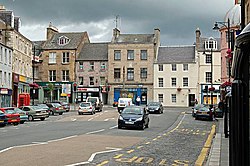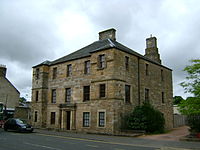Cupar
| Cupar | |
| Fife | |
|---|---|
 Crossgate, Cupar | |
| Location | |
| Grid reference: | NO374146 |
| Location: | 56°19’12"N, 3°-0’44"W |
| Data | |
| Population: | 8,980 (est) |
| Post town: | Cupar |
| Postcode: | KY14 - 15 |
| Dialling code: | 01334 |
| Local Government | |
| Council: | Fife |
| Parliamentary constituency: |
North East Fife |
Cupar is a town and royal burgh in Fife. The town is approximately equidistant between the larger city of Dundee and the New Town of Glenrothes.
Contents
History
The town is believed to have grown around the site of Cupar Castle, which was the seat of the sheriff and was owned by the earls of Fife.[1] The area became a centre for judiciary as the county of Fife and as a market town catering for both cattle and sheep.[2]
Towards the latter stages of the 13th century, the burgh became of great importance, and here in 1276 met an assembly of the three estates, clergy, nobility and burgesses, summoned by King Alexander III; a forerunner of the Parliament of Scotland.[2] Although, written information of a charter for the modern town was lost, evidence has suggested that this did exist as one of the many properties owned by the Earls of Fife by 1294.[1]
During the middle of the 14th century, the burgh started to pay customs on taxable incomes, which probably meant that royal burgh status was gifted sometime between 1294 and 1328.[1] The oldest document, referring to the royal burgh, was a grant by Robert II in 1381 to give a port at Guardbridge on the River Eden for the residents of the burgh to help encourage trade with Flanders.[3] This grant was officially recognised by King James II in 1428.[3]
Sights about the town
The historic hub of the town centre, is the junction of Bonnygate and the Crossgate. This is where the town's mercat cross which dates from 1683 is located with the original shaft being supported by a unicorn.[3] To the east is St Catherine Street, is home to the burgh chambers and county buildings, both designed by Robert Hutchison.[3] The Category B[4] listed burgh chambers built around 1815 and 1818 contain a three storey bow street corner and a robust domic entrance.[3] The adjacent Category B[5] listed county buildings built between 1812 and 1817 are unique in Fife for being the only example replicating the style of buildings in the New Town of Edinburgh.[3][6] The Category B listed tower of the corn exchange can be seen across the skyline of the town.[3]
At the east end of St Catherine Street is the Category B[7] listed Cupar War Memorial in a classical Greek style overlooking the Cart Haugh, one of several to be designed by John Kinross with assistance from leading contemporary sculptors, for the exception of the Victory statue which was done by HS Gamby.[3] The memorial was first unveiled by Field Marshall Earl Haig in 1922 and then again for the addition of the Second World War memorial in 1950 by the Earl of Elgin.[7] Nearby on Coal Road is a former Category B[8] listed classical style prison building built between 1813 and 1814.[3]
On the Bonnygate, the Category A[9] listed Preston Lodge built by the Laird of Airdrie is the second oldest building in the town.[3][10] The date of 1623, when the house was first built, is inscribed on a stone on the west wall.[10] The house was extended in 1702 by James Preston and was remodelled by William Preston, a London goldsmith in 1765.[10] Later, the Reverend Sir James Preston occupied the house between 1775 and 1791, when he was the minister of the Cupar Old Parish Church.[10] The original design of the building is believed to have been inspired by Culross Palace in Culross.[3] Situated at the corner of the Crossgate, the Category C(s)[11] Listed Duncan's institute was built around 1870-71 as a mechanics' institute for the "working classes of Cupar" by Mrs Duncan.[3] The building, a mixture of Gothic, Scottish and Flemish styles is recognised in the town for having a twisted spire.[3] On the Kirkgate, is the Parish Church of Cupar Old and St Michael of Tarvit, designed by the architect, Hay Bell.[3] This consists of the Category A[12] listed Parish Church tower dating from 1415 and the Category B listed main church building from 1745.[3] The tower is the only surviving piece of the old Cupar parish church, founded by the Priory of St Andrews.[3][13]
Hill of Tarvit to the south of the town on the A914 and A916 is a Category A[14] listed mansion house. The Hill of Tarvit was formerly known as Wemyss Hall, designed by Sir Walter Bruce around 1692.[15] When the house was sold in 1904, Robert Lorimer was commissioned to design a bigger house in size compared to the existing Wemyss Hall to be able to hold the owner's French architecture.[15] This was completed around 1907 and 1908, granting the present name Hill of Tarvit.[15][16] The interior of the house which showcased the owner's love of antique furniture from Flemish tapestries through French ancien régime and British work have been considered by many to be Lormier's best work.[15] The service accommodation is the most fascinating aspects of the house which shows the range of rooms and equipment used by a family before the First World War.[15]
Scotstarvit Tower stands between the Tarvit and Walton Hills, a well-preserved simple L-plan early 17th century tower house of five stories and an attic.[17] It is Category A[18] listed.[17]
Sport, recreation & hobbies
Cupar has an unusual golf course on the side of a hill to the South of the town.
Cupar Cricket Club was founded in 1884 and celebrated its 125th anniversary in the 2009 season.
Cupar Sports Centre has a swimming pool, badminton courts, squash courts and a fitness suite.[19]
The Castlehill Community Association is home to a variety of local groups including Cupar Camera Club, Cupar Art Club, Cupar & District Model Railway Club. They operate from the Old Castlehill Primary School and from 11 St Catherine Street.
References
Notes
- ↑ 1.0 1.1 1.2 Martin, Paula Cupar: The history of a small Scottish town pp9–10
- ↑ 2.0 2.1 Lamont-Brown, Raymond Fife in History and Legend p49
- ↑ 3.00 3.01 3.02 3.03 3.04 3.05 3.06 3.07 3.08 3.09 3.10 3.11 3.12 3.13 3.14 3.15 Pride Kingdom of Fife pp106–111
- ↑ "Historic Scotland: County Buildings listed report". Historic Scotland. http://hsewsf.sedsh.gov.uk/hslive/hsstart?P_HBNUM=24160. Retrieved 2011-03-05.
- ↑ "Historic Scotland: County Buildings listed report". Historic Scotland. http://hsewsf.sedsh.gov.uk/hslive/hsstart?P_HBNUM=24161. Retrieved 2011-03-05.
- ↑ Omand, Donald The Fife Book p200
- ↑ 7.0 7.1 "Cupar War Memorial". Historic Scotland. http://hsewsf.sedsh.gov.uk/hslive/hsstart?P_HBNUM=46365. Retrieved 2011-03-05.
- ↑ "Historic Scotland: Watts listed report". Historic Scotland. http://hsewsf.sedsh.gov.uk/hslive/hsstart?P_HBNUM=24290. Retrieved 2011-03-05.
- ↑ "Historic Scotland: Preston Lodge listed report". Historic Scotland. http://hsewsf.sedsh.gov.uk/hslive/hsstart?P_HBNUM=24242. Retrieved 2011-03-05.
- ↑ 10.0 10.1 10.2 10.3 Boyd Cupar: In Old Picture Postcards Volume 2 p.32.
- ↑ "Historic Scotland: Duncan Institute listed report". Historic Scotland. http://hsewsf.sedsh.gov.uk/hslive/hsstart?P_HBNUM=24180. Retrieved 2011-03-05.
- ↑ "Historic Scotland: Parish Church of Cupar Old and St Michael of Tarvit listed report". Historic Scotland. http://hsewsf.sedsh.gov.uk/hslive/hsstart?P_HBNUM=24136. Retrieved 2011-03-05.
- ↑ Omand The Fife Book p.134.
- ↑ "Historic Scotland: Hill of Tarvit listed report". Historic Scotland. http://hsewsf.sedsh.gov.uk/hslive/hsstart?P_HBNUM=2628. Retrieved 2011-03-05.
- ↑ 15.0 15.1 15.2 15.3 15.4 Walker and Ritchie Fife, Perthshire and Angus p.89.
- ↑ Pride Kingdom of Fife p.92.
- ↑ 17.0 17.1 Walker and Ritchie Fife, Perthshire and Angus p.106.
- ↑ "Scotstarvit tower". Historic Scotland. http://hsewsf.sedsh.gov.uk/hslive/hsstart?P_HBNUM=2416. Retrieved 2008-12-20.
- ↑ "Cupar Sports Centre". Fife Council Community Services. 2001. http://www.fifestyle.co.uk/leisure/cupar.htm. Retrieved 2009-02-26.
Books
- Omand, Donald (2000). The Fife Book. Birlinn Publishing.
- Pride, Glen L. (1999). Kingdom of Fife (2nd edition ed.). The Rutland Press.
- Lamont-Brown, Raymond (2002). Fife in History and Legend. Edinburgh: John Donald. ISBN 0859765679.
- Martin, Paula (2006). Cupar: The History of a small Scottish town. Edinburgh: Birlinn Publishing.
Outside links
| ("Wikimedia Commons" has material about Cupar) |



